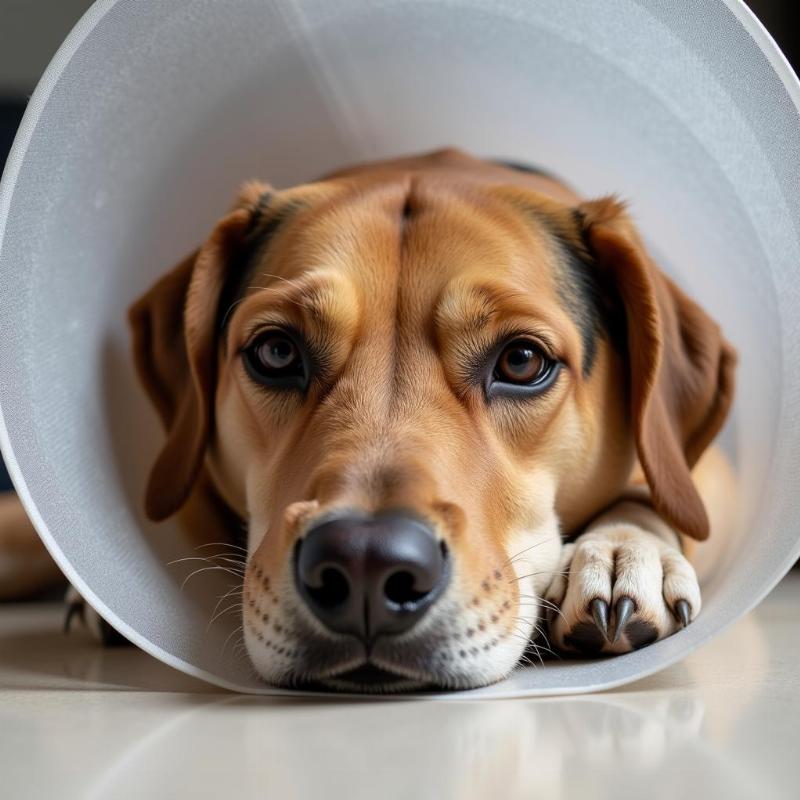Knowing when it’s safe to bathe your dog after surgery is a crucial part of the post-operative care process. While keeping your furry friend clean is important, bathing too soon can disrupt the healing process, potentially leading to infection or other complications. This article provides a comprehensive guide to help you understand the optimal timeline for bathing your dog post-surgery, along with tips for safe and effective cleaning.
Understanding Post-Surgical Care for Dogs
After surgery, your dog’s incision site is vulnerable and requires special attention. Your veterinarian will provide specific instructions regarding post-surgical care, including bathing restrictions. Generally, you should avoid bathing your dog for at least 10-14 days after surgery, or until the sutures or staples are removed. This timeframe allows the incision to close properly and minimizes the risk of infection.
Why Waiting is Crucial After Dog Surgery
Premature bathing can introduce bacteria and moisture to the incision, hindering healing and increasing the risk of infection. Water can also soften the scabs that form over the incision, making them more likely to fall off prematurely. This can expose the underlying tissue and delay the healing process. Furthermore, certain shampoos and soaps can irritate the incision site, causing discomfort and inflammation.
 Dog recovering after surgery
Dog recovering after surgery
When Can I Bathe My Dog After Surgery?
The answer to “how long after surgery can I wash my dog” varies depending on the type of surgery, the size of the incision, and your dog’s overall health. Always consult your veterinarian for personalized advice. They can assess your dog’s specific situation and recommend the appropriate timeframe for bathing. In some cases, your vet may suggest alternative cleaning methods, such as spot cleaning with a damp cloth or using dry shampoo, until it’s safe to give your dog a full bath.
Spot Cleaning Your Dog After Surgery
If your dog gets particularly dirty before it’s safe for a full bath, you can carefully spot clean the affected areas. Use a damp, lukewarm cloth with a mild, veterinarian-approved antiseptic solution. Avoid scrubbing or putting pressure on the incision site. Gently pat the area dry after cleaning.
Tips for Bathing Your Dog Post-Surgery
Once your veterinarian gives you the green light to bathe your dog, follow these tips for a safe and comfortable experience:
- Use lukewarm water. Hot or cold water can cause discomfort and stress to your dog, especially after surgery.
- Choose a mild, veterinarian-approved shampoo. Avoid harsh chemicals and fragrances that can irritate the incision site.
- Avoid getting water directly on the incision. If necessary, cover the incision with a waterproof bandage.
- Gently lather and rinse your dog. Avoid scrubbing or putting pressure on the incision area.
- Dry your dog thoroughly. Damp fur can create a breeding ground for bacteria. Use a soft towel and avoid rubbing the incision site.
Conclusion
Patience is key when it comes to bathing your dog after surgery. Waiting for the appropriate amount of time allows the incision to heal properly and minimizes the risk of complications. Always follow your veterinarian’s instructions regarding post-surgical care, including bathing. By taking these precautions, you can help your furry friend recover quickly and comfortably.
FAQ
- How can I keep my dog clean if I can’t bathe them after surgery? You can use dry shampoo or spot clean with a damp cloth and veterinarian-approved antiseptic solution.
- What should I do if my dog’s incision gets wet before it’s fully healed? Gently pat the area dry with a clean towel and contact your veterinarian.
- Can I use human shampoo on my dog after surgery? No, human shampoos can irritate a dog’s skin, especially after surgery. Always use a veterinarian-approved shampoo.
- What are the signs of infection at the incision site? Redness, swelling, discharge, and excessive licking are potential signs of infection. Contact your veterinarian immediately if you notice any of these symptoms.
- When can I remove my dog’s surgical cone? Follow your veterinarian’s instructions regarding cone removal. Removing it too early can allow your dog to lick or scratch the incision, disrupting the healing process.
- How long does it typically take for a surgical incision to heal in dogs? Most surgical incisions heal within 10-14 days, but the healing time can vary depending on the type of surgery and the individual dog.
- What if my dog rolls in something smelly before the incision is healed? Consult your vet for advice on the best cleaning method. Spot cleaning might be an option.
Related Articles on Beautdogs.us
Beautdogs.us is your premier resource for all things dog-related in the US. We offer expert advice on dog breeds, grooming, training, nutrition, and health. Whether you’re a seasoned dog owner or a new puppy parent, Beautdogs.us provides reliable, comprehensive, and engaging content to help you navigate the joys and challenges of dog ownership. Contact us at [email protected] or +1 501-555-7529 for all your dog-related inquiries. Beautdogs.us is committed to providing the best possible care for your canine companion.